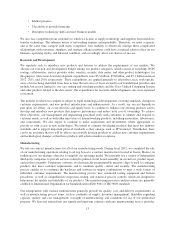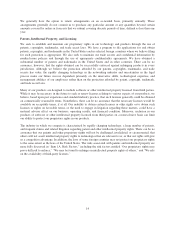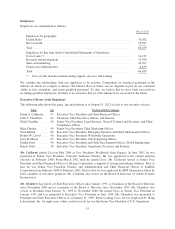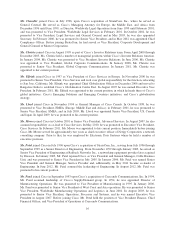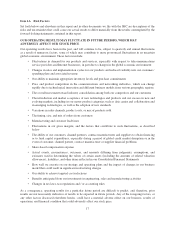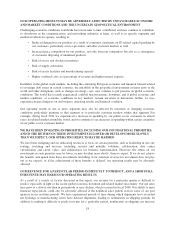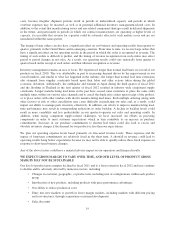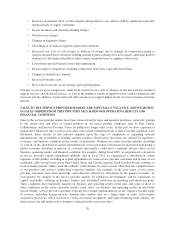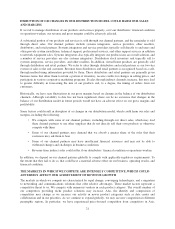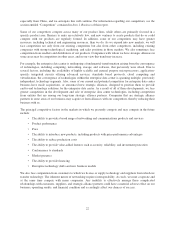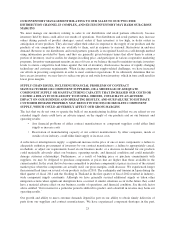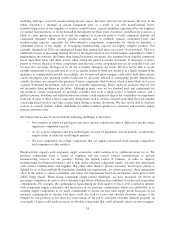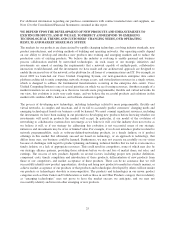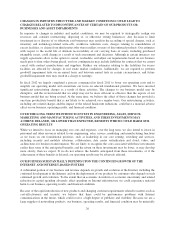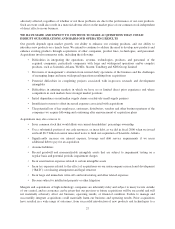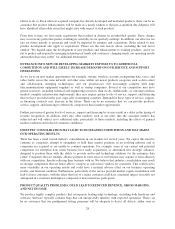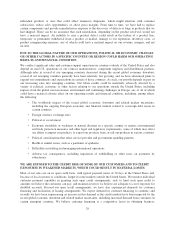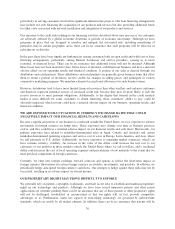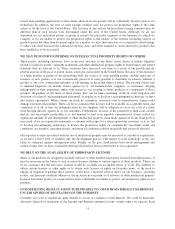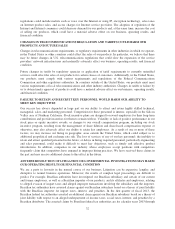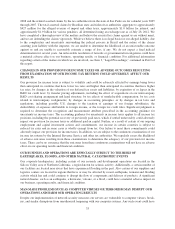Cisco 2012 Annual Report Download - page 31
Download and view the complete annual report
Please find page 31 of the 2012 Cisco annual report below. You can navigate through the pages in the report by either clicking on the pages listed below, or by using the keyword search tool below to find specific information within the annual report.OUR INVENTORY MANAGEMENT RELATING TO OUR SALES TO OUR TWO-TIER
DISTRIBUTION CHANNEL IS COMPLEX, AND EXCESS INVENTORY MAY HARM OUR GROSS
MARGINS
We must manage our inventory relating to sales to our distributors and retail partners effectively, because
inventory held by them could affect our results of operations. Our distributors and retail partners may increase
orders during periods of product shortages, cancel orders if their inventory is too high, or delay orders in
anticipation of new products. They also may adjust their orders in response to the supply of our products and the
products of our competitors that are available to them, and in response to seasonal fluctuations in end-user
demand. Revenue to our distributors and retail partners generally is recognized based on a sell-through method
using information provided by them, and they are generally given business terms that allow them to return a
portion of inventory, receive credits for changes in selling price, and participate in various cooperative marketing
programs. Inventory management remains an area of focus as we balance the need to maintain strategic inventory
levels to ensure competitive lead times against the risk of inventory obsolescence because of rapidly changing
technology and customer requirements. When facing component supply-related challenges, we have increased
our efforts in procuring components in order to meet customer expectations. If we ultimately determine that we
have excess inventory, we may have to reduce our prices and write down inventory, which in turn could result in
lower gross margins.
SUPPLY CHAIN ISSUES, INCLUDING FINANCIAL PROBLEMS OF CONTRACT
MANUFACTURERS OR COMPONENT SUPPLIERS, OR A SHORTAGE OF ADEQUATE
COMPONENT SUPPLY OR MANUFACTURING CAPACITY THAT INCREASED OUR COSTS OR
CAUSED A DELAY IN OUR ABILITY TO FULFILL ORDERS, COULD HAVE AN ADVERSE
IMPACT ON OUR BUSINESS AND OPERATING RESULTS, AND OUR FAILURE TO ESTIMATE
CUSTOMER DEMAND PROPERLY MAY RESULT IN EXCESS OR OBSOLETE COMPONENT
SUPPLY, WHICH COULD ADVERSELY AFFECT OUR GROSS MARGINS
The fact that we do not own or operate the bulk of our manufacturing facilities and that we are reliant on our
extended supply chain could have an adverse impact on the supply of our products and on our business and
operating results:
• Any financial problems of either contract manufacturers or component suppliers could either limit
supply or increase costs
• Reservation of manufacturing capacity at our contract manufacturers by other companies, inside or
outside of our industry, could either limit supply or increase costs
A reduction or interruption in supply; a significant increase in the price of one or more components; a failure to
adequately authorize procurement of inventory by our contract manufacturers; a failure to appropriately cancel,
reschedule, or adjust our requirements based on our business needs; or a decrease in demand for our products
could materially adversely affect our business, operating results, and financial condition and could materially
damage customer relationships. Furthermore, as a result of binding price or purchase commitments with
suppliers, we may be obligated to purchase components at prices that are higher than those available in the
current market. In the event that we become committed to purchase components at prices in excess of the current
market price when the components are actually used, our gross margins could decrease. We experienced longer
than normal lead times on several of our products in fiscal 2010. The earthquake and tsunami in Japan during the
third quarter of fiscal 2011 and the flooding in Thailand in the first quarter of fiscal 2012 resulted in industry-
wide component supply constraints. Although we have generally secured additional supply or taken other
mitigation actions when significant disruptions have occurred, if similar situations occur in the future, they could
have a material adverse effect on our business, results of operations, and financial condition. See the risk factor
above entitled “Our revenue for a particular period is difficult to predict, and a shortfall in revenue may harm our
operating results.”
Our growth and ability to meet customer demands depend in part on our ability to obtain timely deliveries of
parts from our suppliers and contract manufacturers. We have experienced component shortages in the past,
23


